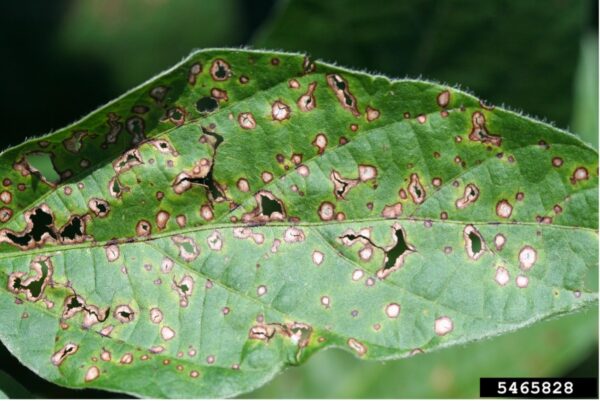To many, science can seem like magic. Abracadabra and *whoosh* something appears seemingly out of thin air. However mystical and misunderstood science can be, it is not magic. It is science. As such, things cannot be manifested out of nothing.
“But Chelsea, why on earth are you talking about science and magic?”
Simply put, I want to spin you a cautionary tale that may be more familiar than you realize. The tale is that of fungicides and disease management in soybean.
Fungicide use to manage corn and soybean diseases started nearly two decades ago. It took less than ten years of use before fungicide resistance was found in populations of soybean-pathogenic fungi. Researchers identified QoI (strobilurin) resistant isolates of the causal agent of frogeye leaf spot (Fig. 1) (Cercospora sojina) for the first time in 2010 from a field in Tennessee. Strobilurin resistant frogeye leaf spot has been found in 20 more states since. More soybean fungal pathogens causing other diseases have developed fungicide resistance in the time since, including Septoria leaf spot and Cercospora leaf blight.

Soybean leaf showing symptoms of frogeye leaf spot caused by the fungal pathogen Cercospora kikuchii. (Daren Mueller, Iowa State University, Bugwood.org).
What does this mean for soybean disease management?
To get to the answer of that question, I ask you another. Do you know how many different fungicide FRAC groups are available for use on soybean? Think of FRAC groups like a “mode-of-action”. The most commonly used fungicides for soybean disease management come from just three different FRAC groups- QoIs (strobilurins), DMIs (triazoles) and SDHIs (carboxamides). With so few “modes-of-action” available to use, the application of a fungicide at all must be incredibly strategic.
Generally, we suggest never using a single “mode-of-action” in a spray application in order to avoid fungicide resistance development. Well, nowadays, most fungicides come as premixes (more than one active ingredient). But what if you’re applying a premix onto a field that has fungal populations that are resistant to one of the ingredients? In essence, you’re applying a single ingredient!
So how do you really manage foliar soybean diseases? Let us not forget basics of disease management, which I wrote a blog post on recently. A lot of this shakes down to integrated pest management and thinking of other tools to help mitigate diseases aside from fungicide application. If you know you have a history of a foliar disease, pick a cultivar that has resistance or tolerance to that disease. Scout those fields when weather has been suitable for disease development so you can make informed decisions about whether fungicide applications are really necessary.
Applying fungicides just because they seem cost-effective even when disease pressure is low is not responsible stewardship of the technology we have available to us. Remember, we have very few FRAC groups for fungicides in row crops, and the development of new FRAC groups is not something that can just magically happen. What we have is what we have. We are responsible for being responsible stewards of what we have to ensure it has longevity in our systems.
Another resource that can help you with fungicide decisions is the Crop Protection Network’s fungicide efficacy table. This table is updated annually based on input from field crops pathologists.
As for the current growing season, take a moment to consider whether conditions have been favorable for disease development to this point. Early planted beans have achieved canopy closure, but later planted fields remain small and are struggling to grow without water. It’s been a long, dry June. And the forecast doesn’t look very hopeful for any substantial rainfall. (I had to come back to this blog to note that in Knox County we received more than 2” of rain on Saturday June 25!)
When the heat and dryness is persistent, conditions are not really favorable for disease development, especially when soybean stands are struggling to even close canopy. Time will tell how the weather will change. If and or when we get more moisture and cooler temperatures, I simply ask of you to be mindful with your fungicide application decisions – is it really necessary or are you doing more harm than good with regard to the fungal pathogens that might be causing minimal disease in your field?


 and then
and then